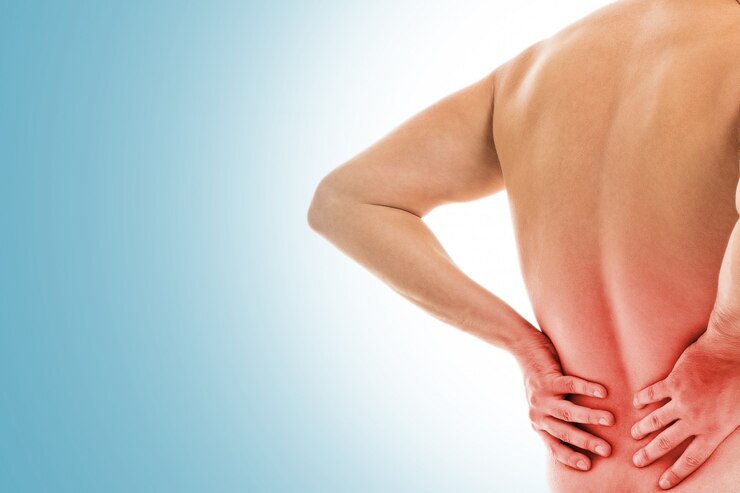The biggest cause of back pain is poor posture and lack of physical activity. These factors contribute to muscle imbalances, tightness, and strain on the spine, leading to discomfort and pain.
When the muscles supporting the spine are weak or imbalanced, it can result in poor alignment and pressure on the vertebrae, causing back pain. Additionally, a sedentary lifestyle and frequent heavy lifting can also contribute to back pain. It’s important to maintain good posture, engage in regular exercise, and use proper lifting techniques to prevent and alleviate back pain.
Seeking professional advice and treatment for persistent back pain is crucial to address the root cause and improve overall spinal health. By understanding the primary causes of back pain, individuals can take proactive steps to prevent and manage this common issue.
Photo Credit: https://www.freepik.com
What Triggers Back Pain?
Back pain is a prevalent issue that affects people of all ages and can be caused by various factors. Understanding the triggers of back pain is crucial in preventing and managing this condition. Among the biggest causes of back pain are poor posture and a sedentary lifestyle. Let’s delve into how these factors contribute to back pain.
Poor Posture
Poor posture significantly contributes to back pain as it puts unnecessary strain on the spine and surrounding muscles. Slouching, hunching over a desk, or standing improperly can lead to imbalances in muscle strength and alignment, leading to discomfort and pain. The undue pressure on the spine, especially the lower back, can exacerbate existing issues or create new ones, resulting in chronic back pain.
Sedentary Lifestyle
A sedentary lifestyle characterized by prolonged sitting and minimal physical activity can also be a major trigger for back pain. Sitting for extended periods can weaken the muscles that support the spine, leading to muscular imbalances and reduced flexibility, which contributes to discomfort and pain. Additionally, a lack of movement can lead to stiffness and reduced blood flow, exacerbating back pain.
The Role Of Muscle Strain
One of the biggest causes of back pain is muscle strain, which occurs when the muscles are stretched beyond their limits, leading to tiny tears in the muscle fibers. This can happen due to a variety of reasons, such as heavy lifting or sudden movements. Understanding the role of muscle strain in causing back pain is essential in preventing and managing this common ailment.
Heavy Lifting
Heavy lifting is a common cause of muscle strain and subsequent back pain. When lifting heavy objects, the muscles in the back are put under significant pressure, leading to strain and potential injury. It’s important to use proper lifting techniques and, if needed, seek assistance to avoid overstressing the muscles.
Sudden Movements
Sudden movements, such as twisting or bending abruptly, can also lead to muscle strain in the back. These movements can put excessive stress on the muscles, leading to pain and discomfort. It’s crucial to be mindful of body mechanics and movements to prevent sudden strain on the muscles.
Impact Of Spinal Disorders
Spinal disorders can significantly contribute to back pain, affecting millions of people worldwide. These conditions can lead to various symptoms, including discomfort, limited mobility, and reduced quality of life. Understanding the impact of spinal disorders is crucial in addressing the root cause of back pain and implementing effective treatment strategies.
Herniated Discs
Herniated discs, also known as slipped or ruptured discs, occur when the soft inner core of the intervertebral disc bulges out through the outer layer. This condition can exert pressure on the surrounding nerves, leading to pain, tingling, or numbness in the back, buttocks, or legs. The impact of herniated discs on spinal health can result in debilitating discomfort and impaired functionality.
Degenerative Disc Disease
Degenerative disc disease is characterized by the gradual breakdown of the spinal discs, often accompanied by a reduction in disc height and the development of bone spurs. This process can contribute to instability in the spine, leading to chronic pain and decreased flexibility. Understanding the impact of degenerative disc disease is essential for devising targeted treatment plans that address the underlying structural changes.
Photo Credit: https://www.freepik.com
Exploring Mechanical Issues
When it comes to exploring the causes of back pain, mechanical issues play a significant role in contributing to discomfort and limitations in mobility. Understanding the mechanical factors that can lead to back pain is crucial in developing targeted treatment and preventive strategies. Among these mechanical issues, misaligned vertebrae and joint dysfunction are key contributors to back pain that warrant close attention.
Misaligned Vertebrae
Misaligned vertebrae, also known as vertebral subluxation, can exert pressure on the surrounding nerves, causing pain and discomfort. When the vertebrae are not properly aligned, it can affect the spinal column’s ability to support body weight, leading to muscle strain and potential nerve impingement. This misalignment can be the result of poor posture, repetitive motions, or sudden trauma.
Joint Dysfunction
Joint dysfunction in the spine can significantly contribute to back pain. The joints in the spine, known as facet joints, can become dysfunctional due to conditions such as osteoarthritis, injury, or overuse. When these facets do not move correctly or become inflamed, it can result in pain, stiffness, and reduced mobility. Over time, joint dysfunction can lead to chronic back pain if not addressed effectively.
Lifestyle Factors And Back Pain
When it comes to understanding the causes of back pain, lifestyle factors play a crucial role. Choices we make in our day-to-day lives can significantly impact the health of our back. Two major contributors to back pain are obesity and stress and anxiety.
Obesity
Obesity is a common problem in today’s society and is linked to various health issues, including back pain. The excess weight puts added strain on the spine and can lead to structural changes that cause discomfort. Moreover, it can also contribute to the development of conditions such as herniated discs and osteoarthritis.
Stress And Anxiety
Stress and anxiety can manifest physically, leading to tension in the muscles of the back and causing discomfort. Chronic stress can result in increased muscle tension and inflammation, contributing to a higher likelihood of experiencing back pain. Additionally, it can lead to poor posture and unhealthy coping mechanisms such as overeating, which, in turn, can contribute to obesity-related back pain.
Frequently Asked Questions On What Is The Biggest Cause Of Back Pain?
What Are The Common Causes Of Back Pain?
Back pain can be caused by muscle strain, poor posture, heavy lifting, or sudden movements. Injuries, arthritis, and skeletal irregularities may also contribute to back pain. Understanding the specific cause is crucial for effective treatment.
How Can I Prevent Back Pain?
Maintaining proper posture, exercising regularly, lifting heavy objects correctly, and using ergonomic furniture can help prevent back pain. Additionally, staying within a healthy weight range and avoiding prolonged sitting or standing can reduce the risk of developing back pain.
When Should I Seek Medical Help For Back Pain?
If your back pain is severe and persistent or is accompanied by other symptoms such as numbness, tingling, or weakness in your legs, it’s essential to seek medical attention promptly. This could indicate a more serious underlying issue that needs professional evaluation.
Conclusion
Understanding the root cause of back pain is crucial for effective prevention. By addressing lifestyle factors, optimizing ergonomic practices, and seeking professional guidance, individuals can mitigate the risk of developing chronic back pain. Bringing awareness to the significant impact of these factors is essential in empowering individuals to take proactive steps towards better back health.



